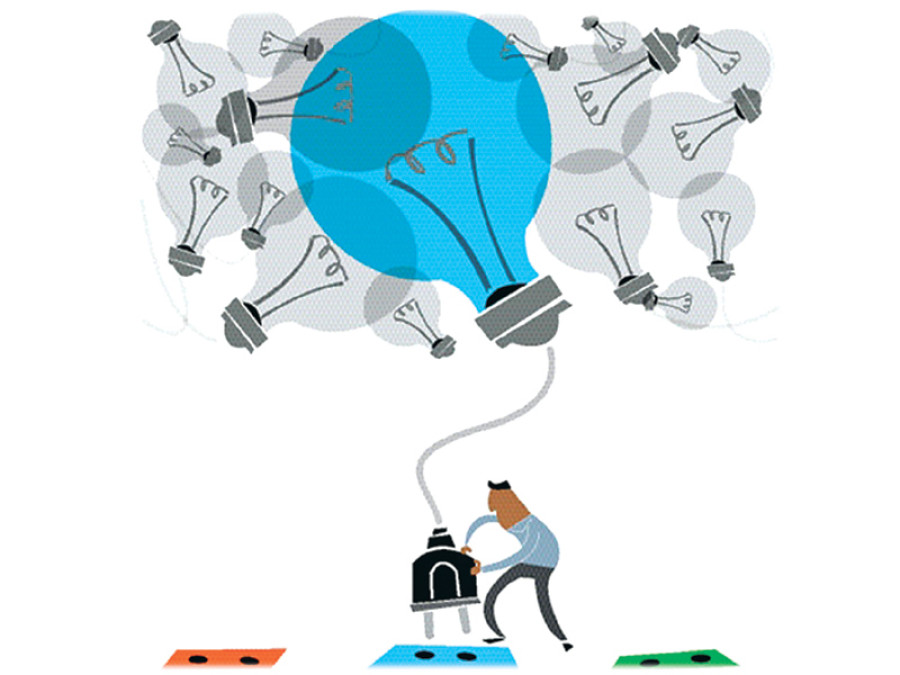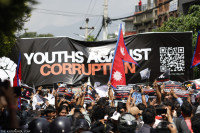Opinion
More power to the people
The best loss reduction strategy is avoiding transmitting electricity over long distances
Pramod Raj Pokharel
The quality of the Nepal Electricity Authority’s (NEA) distribution system is no more a secret. During the recent Indian blockade when LPG deliveries stopped and Nepali kitchens had to turn to electricity to keep the fires going, the lights dimmed in urban and peri-urban areas, which clearly showed its inability to handle high distribution loads. The reason why the NEA’s distribution system performed poorly is its long radial feed nature. The Integrated Nepal Power System (INPS) under the NEA has been sustaining massive system losses. In the fiscal year 2014-15, the INPS suffered losses totalling 1,211 GWh (gigawatt hour), or 24.44 percent of the total energy available in the grid. Out of the lost units, 756.5 GWh were under the 33 kV level. This loss termed as Distribution Consumer Service (DCS) loss includes losses in 33 kV lines, 33/11 kV step-down facilities, 11 kV lines, 11/0.4/0.23 kV step-down facilities and 0.4/0.23 kV lines.
Without loss segregation, it is always confusing to the general public to identify the most loss-prone areas among these five. But realising the fact that transformers are the most efficient electric devices and losses in 33 kV and 11 kV lines are at least 10,000 and 1,000 times lower respectively compared to low voltage lines for the same amount of power flow in the same circuit configuration, one can easily guess where significant DCS losses are occurring.
To overcome the present deficiency of long radial feed systems and relieve the NEA of unbearable distribution system losses, it is necessary to construct many new area substations with 1,000 km of new and parallel feeder lines. The use of large-sized conductors, installation of additional transformers and relocation of the existing transformers closer to bigger loads are other requirements.
This is because “the shorter the length of the low voltage line, the better will be the system performance”. In the developed countries where distribution losses have been limited to five to seven percent, many small-sized transformers are used. They also have high voltage distribution feeder systems (33+ kV) each serving only a few consumers located close together. Unfortunately, this is not the case in Nepal, and many load centres have large-sized transformers (160 kVA and 100 kVA) with low voltage lines extending over four to five km.
Thinking differently
A comprehensive reinforcement of the distribution system costs a significant amount of money, and the process is never ending. So it is time to think differently and use the existing infrastructure as much as possible. The best alternative is to discard the radial feed system and go for a hybrid system with distributed generation from renewable sources. Widespread use of bulk solar generation and injecting power into the low voltage system will be one of the easiest options. When energy is fed this way, there is no need for large-sized conductors and the expenses of installing additional transformers and rehab lines can be avoided. It will also reinforce the entire distribution system as the current flowing in the network drops significantly.
In the present context where the NEA’s supply system is highly congested and needs thorough upgradation, the best solution is to create as much local generation as possible to meet local energy demand. Today, the best loss reduction strategy is avoiding transmitting power over long distances. Distributed generation is the best way to counter the existing INPS losses for the time being. No other way is as cost-effective as distributed generation that provides an alternative way for system reinforcement with local generation and by-product loss reduction. Theoretically, if the effective current flowing in the circuitry is reduced by half and the conductor type throughout the circuitry is assumed to be the same, half load sharing from both the ends will reduce the line loss figure by 75 percent. This not only improves the voltage profile in the segment but generates a positive feedback loop to other nodes of the network thus helping to produce further loss reduction.
Way forward
As per the NEA’s annual report, it incurred a net loss of Rs6,510.04 million in fiscal 2014-15. This provides not only a huge business option but overcoming this loss will enable the INPS to have about 100 MW of inbuilt generation capacity within its own system. Leasing high-loss 33 kV and 11 kV feeders from the NEA and using a distributed generation concept with optimised mini hydro, solar/wind and other renewable energy technologies (RETs) is what the NEA’s distribution system presently needs. The distributed generation power injection can be done at the low voltage distribution transformer level to avoid step-up costs.
The most effective way to implement feeder leasing would be through energy contracting and ESCO (energy service company) concepts, where ESCO will be the legal entity for such a contract with the client the NEA. Unfortunately, Nepal does not have ESCO practices like in the developed world, and it is high time the country established them. It will not only reduce the NEA’s administrative and technical burden but also help it to become a more efficient and transparent entity. Effective use of ESCOs can reduce the NEA’s staff burden by over 75 percent. And not all at once, but gradually, ESCOs can help the NEA end power outages in most of its distribution feeders.
Pokharel is an energy expert and a global change manager




 8.12°C Kathmandu
8.12°C Kathmandu










